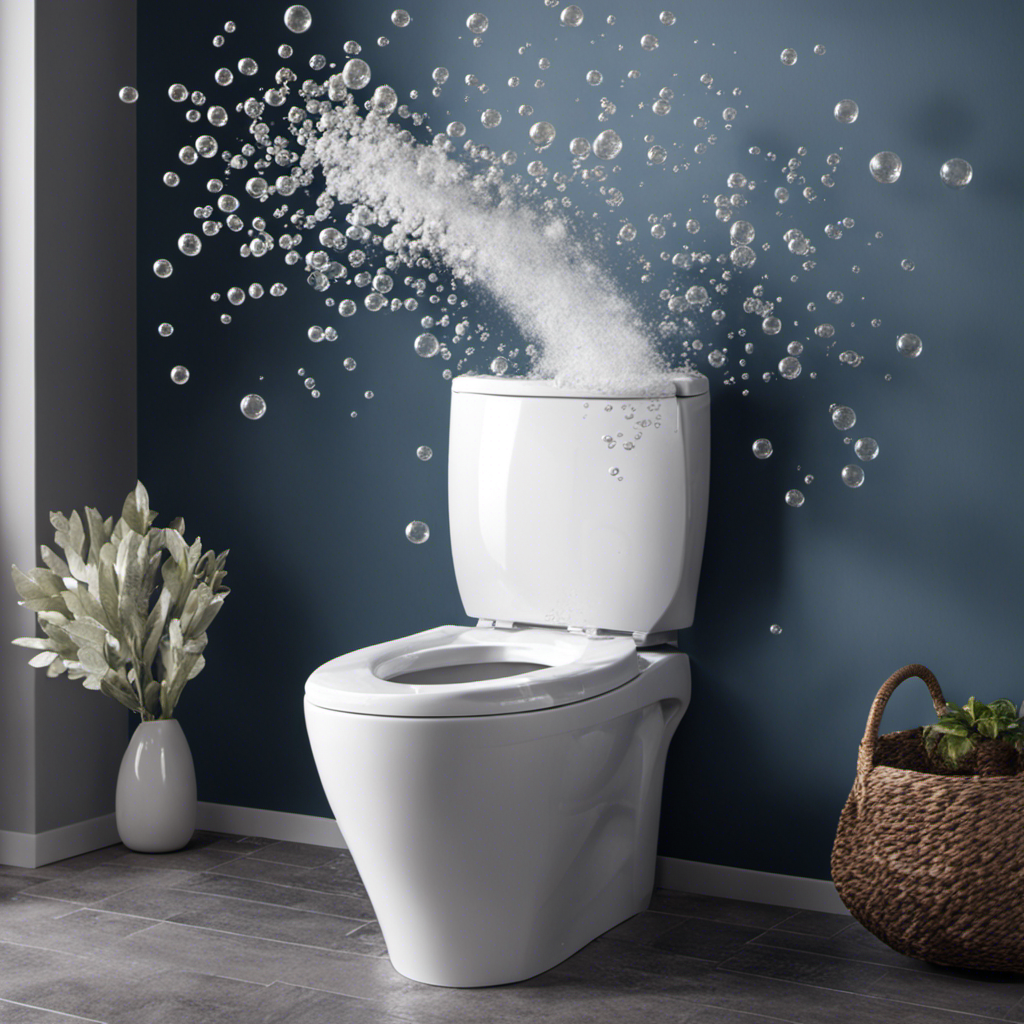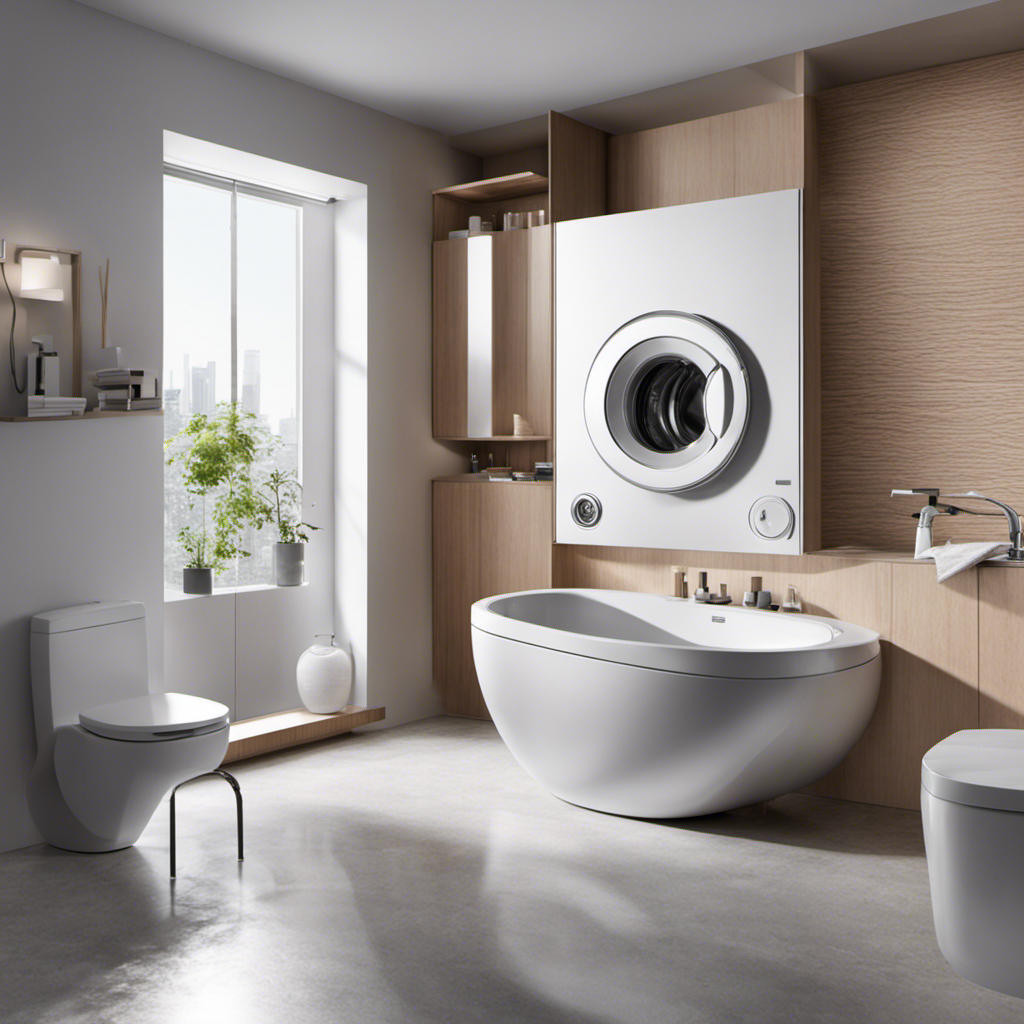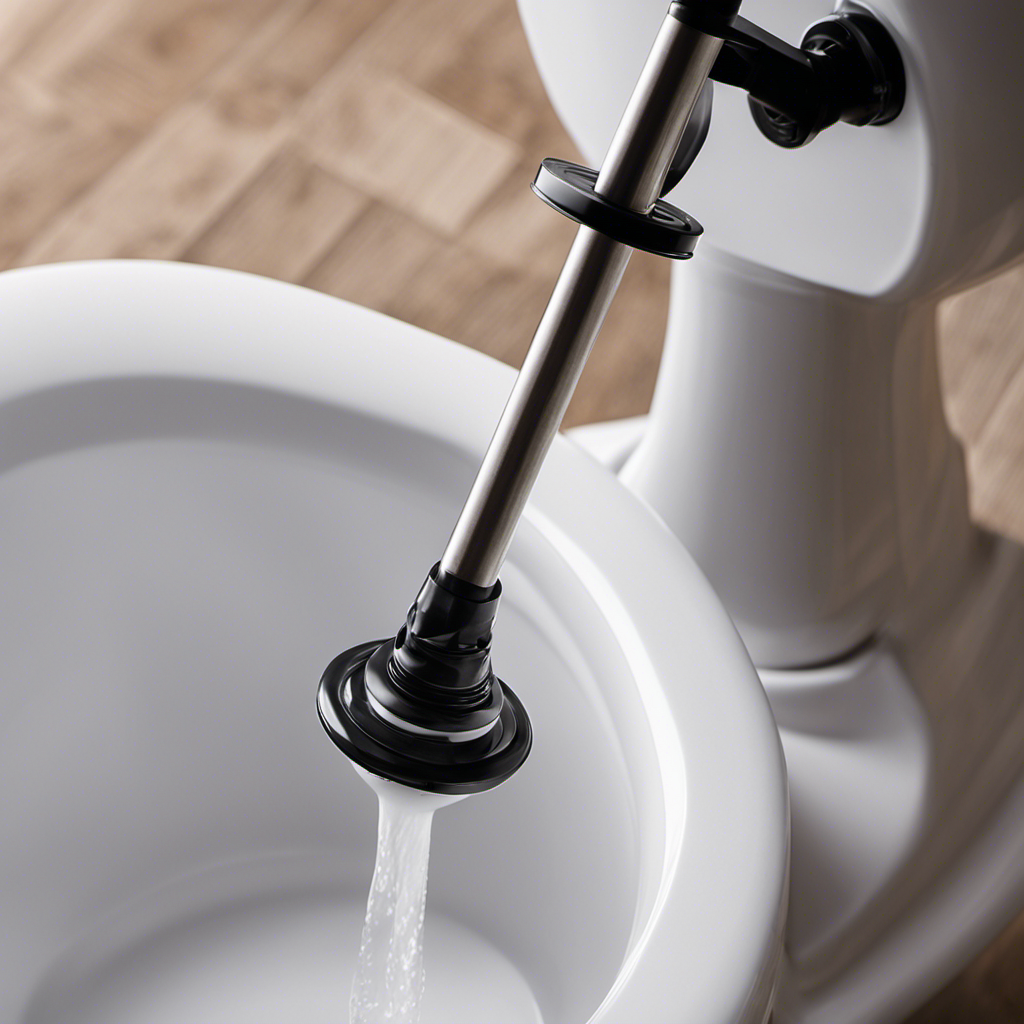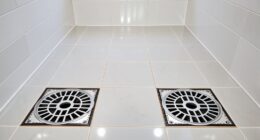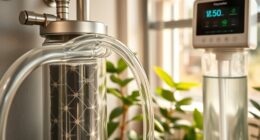I’ve encountered my fair share of plumbing problems, but nothing quite compares to the frustration of a toilet bubbling when the washer drains. It’s like a symphony of gurgling and splashing that leaves you feeling helpless.
In this article, I’ll walk you through the common causes of this issue, the possible plumbing problems behind it, and how to diagnose and fix the problem.
With a little know-how and some preventive measures, you can put an end to this bubbling nightmare once and for all.
Key Takeaways
- Toilet bubbling when the washer drains can be caused by a clogged or blocked sewer line.
- Obstructed venting system can also lead to toilet bubbling when the washer drains.
- Faulty or damaged toilets can contribute to toilet bubbling when the washer drains.
- Regular plumbing maintenance and inspections are important to prevent toilet bubbling and other plumbing issues when the washer drains.
Common Causes of Toilet Bubbling
One of the most common causes of toilet bubbling is a clogged or blocked sewer line. When the sewer line is obstructed, it prevents proper venting and can cause air to get trapped in the plumbing system. This trapped air then escapes through the path of least resistance, which in this case is the toilet bowl.
To resolve this issue, venting maintenance is essential. Regularly inspecting and cleaning the vents can prevent blockages and ensure proper airflow. Additionally, toilet repair may be necessary if the bubbling is a result of a faulty or damaged toilet.
By addressing these common causes, you can eliminate toilet bubbling and maintain a properly functioning plumbing system.
Now, let’s explore other possible plumbing issues that can lead to toilet bubbling.
Possible Plumbing Issues
If you’re experiencing a toilet bubbling when your washer drains, it could be a sign of possible plumbing issues. This is a common problem that many homeowners face, and it’s important to address it promptly to avoid further damage.
Here are some potential plumbing issues that could be causing the toilet to bubble:
-
Clogged drain pipe: A blockage in the drain pipe can cause water to back up and create air bubbles in the toilet.
-
Venting problems: If there is a problem with the venting system, it can disrupt the proper flow of air and water, leading to bubbling in the toilet.
-
Sewer line issues: A damaged or clogged sewer line can cause water to back up and create pressure in the plumbing system, resulting in bubbling in the toilet.
-
Water pressure imbalance: If the water pressure in your home is unbalanced, it can cause air bubbles to form in the toilet when the washer drains.
-
Improperly installed plumbing: If the plumbing system was not installed correctly, it can lead to various issues, including bubbling in the toilet.
While some of these issues can be resolved with basic plumbing maintenance, others may require professional help. It’s important to consult a plumber to diagnose and fix the problem accurately.
Don’t delay in addressing the issue to prevent further damage and ensure the smooth functioning of your plumbing system.
Signs of a Clogged Drain
I’ve encountered many plumbing issues throughout my career. Three common signs of a clogged drain are slow draining sinks, foul odors from drains, and water backup in the bathtub.
When the sink takes longer than usual to drain, it’s often due to a blockage that restricts the flow of water.
Additionally, foul odors emanating from drains can indicate a buildup of debris and bacteria.
Lastly, if you notice water backing up in the bathtub when you use other fixtures in your home, it’s a clear indication of a clogged drain that needs immediate attention.
Slow Draining Sinks
The slow draining sinks in our house have been causing a lot of frustration lately. It’s time for some plumbing maintenance to address this issue. Here are some key points to consider:
- Water swirling around in the sink but taking forever to go down.
- A foul odor emanating from the drain, indicating a buildup of debris.
- Gurgling noises coming from the pipes, suggesting a partial blockage.
- Water backing up into other fixtures, such as the bathtub or toilet.
- Visible residue or grime accumulating around the drain, indicating a slow flow.
To resolve these slow draining sinks, it is important to perform regular maintenance. This includes using a plunger or drain snake to remove any clogs, flushing the drains with hot water and vinegar to dissolve any buildup, and ensuring proper ventilation in the plumbing system to prevent blockages.
Investing in professional plumbing services can also help identify and fix any underlying issues causing the slow drain. With proper maintenance, the frustration of slow draining sinks can be a thing of the past.
Foul Odor From Drains
One way to address the foul odor from your drains is by pouring a mixture of baking soda and vinegar down the sink.
This DIY drain cleaning method is effective in preventing foul odors caused by buildup and bacteria in the pipes.
Baking soda acts as a natural deodorizer and vinegar helps to break down any grease or grime that may be causing the odor.
To use this method, start by pouring a cup of baking soda down the drain, followed by a cup of vinegar.
Let the mixture sit for about 30 minutes, then flush it out with hot water.
This simple and cost-effective solution can help keep your drains smelling fresh and clean.
Water Backup in Bathtub
If water is backing up in your bathtub, it could be a sign of a clog in the plumbing system. This issue can be caused by various factors, such as debris buildup, tree root intrusion, or a damaged sewer line.
To better understand the problem, it is important to consider the following:
-
Water pressure: High water pressure can put stress on your plumbing system and increase the likelihood of clogs.
-
Debris accumulation: Over time, hair, soap scum, and other debris can accumulate in your pipes, leading to blockages.
-
Pipe damage: Cracked or damaged pipes can cause water to back up in your bathtub.
-
Tree root intrusion: Tree roots seeking water and nutrients can infiltrate your plumbing system, causing blockages.
-
Plumbing maintenance: Regular maintenance, such as drain cleaning and inspections, can help prevent clogs and identify potential issues early on.
To prevent water backups in your bathtub, it is essential to maintain proper water pressure, regularly clean your drains, and address any plumbing issues promptly.
How to Diagnose the Problem
In diagnosing the problem of a toilet bubbling when the washer drains, there are two key points to consider: possible drain blockage and venting issues.
A possible drain blockage could be causing water to back up and create pressure, resulting in the bubbling effect.
Additionally, venting issues can occur when the plumbing system lacks proper ventilation, causing air to be trapped and forcing it to escape through the toilet, leading to the bubbling phenomenon.
Possible Drain Blockage
You might have a drain blockage if your toilet is bubbling when the washer drains. When this happens, it’s important to address the issue promptly to prevent further damage.
Here are some unclogging tips you can try before seeking professional plumbing assistance:
- Plunger: Use a plunger to create suction and dislodge the blockage.
- Hot water: Pour hot water down the drain to break up any grease or debris.
- Chemical drain cleaner: Use a chemical drain cleaner to dissolve the clog.
- Plumbing snake: Insert a plumbing snake into the drain and maneuver it to break up the obstruction.
- Enzyme-based cleaner: Try using an enzyme-based cleaner that breaks down organic materials.
If these unclogging tips don’t work, it’s time to call in a professional plumber who has the expertise and tools to tackle stubborn drain blockages.
Venting Issues Causing Bubbling
Addressing venting issues promptly can help prevent bubbling in the drain.
When it comes to toilet venting and plumbing venting, it’s important to understand how these systems work in order to troubleshoot and resolve any issues.
The purpose of toilet venting is to ensure proper air circulation in the plumbing system, preventing air pressure imbalances and allowing wastewater to flow smoothly.
If there is a blockage or restriction in the venting system, it can lead to air being trapped in the pipes, causing bubbling in the drain when the washer drains. This can be a sign of a venting issue that needs to be addressed.
Checking for obstructions in the vent pipe, ensuring proper installation and maintenance, and seeking professional assistance if needed are all crucial steps in resolving venting issues and preventing drain bubbling.
Steps to Fix Toilet Bubbling
To fix toilet bubbling, start by checking the plumbing connections. Ensure that the drain pipe is securely connected to the toilet and that there are no leaks or blockages.
Here are some steps to prevent bubbling and address common toilet problems:
-
Inspect the fill valve: Ensure that the fill valve is functioning properly and that the water level in the tank is at the correct height.
-
Clean the toilet bowl: Remove any clogs or debris that may be causing the bubbling by using a plunger or a toilet auger.
-
Check the vent pipe: Make sure that the vent pipe on the roof is clear of any obstructions or debris that might be affecting the air flow.
-
Adjust the water pressure: If the water pressure is too high, it can cause the toilet to bubble. Install a pressure-reducing valve if necessary.
-
Call a professional: If the problem persists or if you are unsure how to fix it yourself, it’s best to consult a plumber.
Preventive Measures to Avoid Future Issues
Now that we have successfully fixed the toilet bubbling issue, it is crucial to understand the importance of regular plumbing maintenance to prevent future problems. Regular maintenance helps to identify and address any potential issues before they escalate into major plumbing emergencies. By scheduling routine inspections, homeowners can ensure that their plumbing system is in good working order and prevent costly repairs down the line.
One common problem that can lead to toilet bubbling is drain blockages. To prevent these blockages, it is essential to be cautious about what goes down your drains. Avoid disposing of grease, oil, or food scraps down the kitchen sink, as they can solidify and clog the pipes. Additionally, using drain strainers or screens can help catch hair, soap residue, and other debris that may accumulate and cause blockages.
Conclusion
In conclusion, toilet bubbling when the washer drains can be a sign of underlying plumbing issues that must be addressed promptly. By understanding the common causes and signs of a clogged drain, you can diagnose the problem and take the necessary steps to fix it.
Remember to seek professional help if needed and consider implementing preventive measures to avoid future issues. Don’t let this mysterious bubbling go unresolved, for it could lead to more serious complications down the line.
Stay informed, stay proactive, and ensure your plumbing system functions flawlessly.
